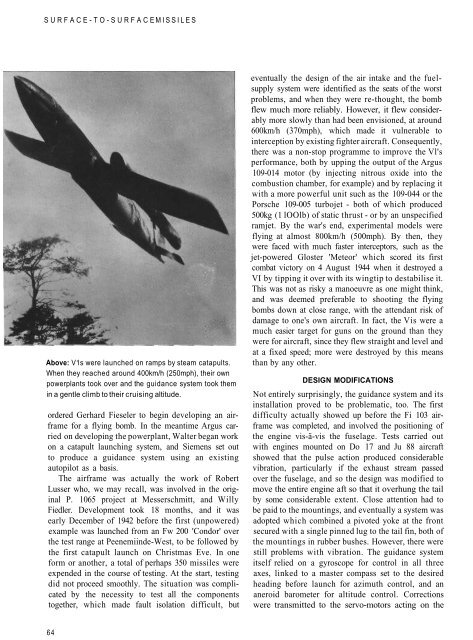Submarines and their Weapons - Aircraft of World War II
Submarines and their Weapons - Aircraft of World War II
Submarines and their Weapons - Aircraft of World War II
You also want an ePaper? Increase the reach of your titles
YUMPU automatically turns print PDFs into web optimized ePapers that Google loves.
SURFACE-TO-SURFACE MISSILES<br />
Above: V1s were launched on ramps by steam catapults.<br />
When they reached around 400km/h (250mph), <strong>their</strong> own<br />
powerplants took over <strong>and</strong> the guidance system took them<br />
in a gentle climb to <strong>their</strong> cruising altitude.<br />
ordered Gerhard Fieseler to begin developing an airframe<br />
for a flying bomb. In the meantime Argus carried<br />
on developing the powerplant, Walter began work<br />
on a catapult launching system, <strong>and</strong> Siemens set out<br />
to produce a guidance system using an existing<br />
autopilot as a basis.<br />
The airframe was actually the work <strong>of</strong> Robert<br />
Lusser who, we may recall, was involved in the original<br />
P. 1065 project at Messerschmitt, <strong>and</strong> Willy<br />
Fiedler. Development took 18 months, <strong>and</strong> it was<br />
early December <strong>of</strong> 1942 before the first (unpowered)<br />
example was launched from an Fw 200 'Condor' over<br />
the test range at Peenemiinde-West, to be followed by<br />
the first catapult launch on Christmas Eve. In one<br />
form or another, a total <strong>of</strong> perhaps 350 missiles were<br />
expended in the course <strong>of</strong> testing. At the start, testing<br />
did not proceed smoothly. The situation was complicated<br />
by the necessity to test all the components<br />
together, which made fault isolation difficult, but<br />
64<br />
eventually the design <strong>of</strong> the air intake <strong>and</strong> the fuelsupply<br />
system were identified as the seats <strong>of</strong> the worst<br />
problems, <strong>and</strong> when they were re-thought, the bomb<br />
flew much more reliably. However, it flew considerably<br />
more slowly than had been envisioned, at around<br />
600km/h (370mph), which made it vulnerable to<br />
interception by existing fighter aircraft. Consequently,<br />
there was a non-stop programme to improve the Vl's<br />
performance, both by upping the output <strong>of</strong> the Argus<br />
109-014 motor (by injecting nitrous oxide into the<br />
combustion chamber, for example) <strong>and</strong> by replacing it<br />
with a more powerful unit such as the 109-044 or the<br />
Porsche 109-005 turbojet - both <strong>of</strong> which produced<br />
500kg (1 lOOlb) <strong>of</strong> static thrust - or by an unspecified<br />
ramjet. By the war's end, experimental models were<br />
flying at almost 800km/h (500mph). By then, they<br />
were faced with much faster interceptors, such as the<br />
jet-powered Gloster 'Meteor' which scored its first<br />
combat victory on 4 August 1944 when it destroyed a<br />
VI by tipping it over with its wingtip to destabilise it.<br />
This was not as risky a manoeuvre as one might think,<br />
<strong>and</strong> was deemed preferable to shooting the flying<br />
bombs down at close range, with the attendant risk <strong>of</strong><br />
damage to one's own aircraft. In fact, the Vis were a<br />
much easier target for guns on the ground than they<br />
were for aircraft, since they flew straight <strong>and</strong> level <strong>and</strong><br />
at a fixed speed; more were destroyed by this means<br />
than by any other.<br />
DESIGN MODIFICATIONS<br />
Not entirely surprisingly, the guidance system <strong>and</strong> its<br />
installation proved to be problematic, too. The first<br />
difficulty actually showed up before the Fi 103 airframe<br />
was completed, <strong>and</strong> involved the positioning <strong>of</strong><br />
the engine vis-ä-vis the fuselage. Tests carried out<br />
with engines mounted on Do 17 <strong>and</strong> Ju 88 aircraft<br />
showed that the pulse action produced considerable<br />
vibration, particularly if the exhaust stream passed<br />
over the fuselage, <strong>and</strong> so the design was modified to<br />
move the entire engine aft so that it overhung the tail<br />
by some considerable extent. Close attention had to<br />
be paid to the mountings, <strong>and</strong> eventually a system was<br />
adopted which combined a pivoted yoke at the front<br />
secured with a single pinned lug to the tail fin, both <strong>of</strong><br />
the mountings in rubber bushes. However, there were<br />
still problems with vibration. The guidance system<br />
itself relied on a gyroscope for control in all three<br />
axes, linked to a master compass set to the desired<br />
heading before launch for azimuth control, <strong>and</strong> an<br />
aneroid barometer for altitude control. Corrections<br />
were transmitted to the servo-motors acting on the


